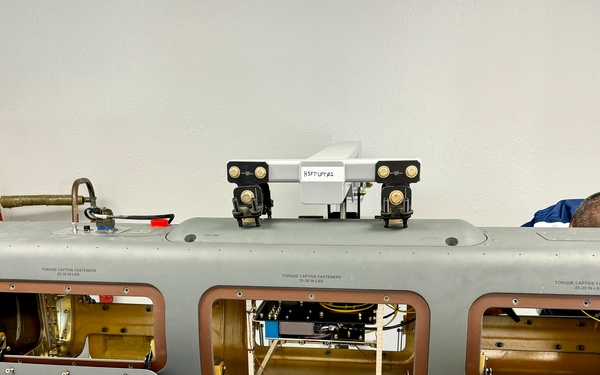EDWARDS AIR FORCE BASE, Calif. -- The United States Air Force Test Pilot School’s research division, in partnership with the 586th Flight Test Squadron at Holloman AFB and NASA’s Armstrong Flight Research Center, recently conducted a flight test campaign verifying the use of the new AgilePod. Dubbed “Have STRAINger Things,” the tests verified the AgilePod’s utility for rapid airborne experimentation, aimed at reducing lead times and costs that traditionally hinder flight-testing efforts.
NASA’s Armstrong Flight Research Center developed a unique Fiber Optic Sensing System, known as FOSS. While legacy copper straining has been used for flight test instrumentation since the 1930’s, it requires extensive time and effort to modify the aircraft with resistive strain sensors. With FOSS, dedicated fiber optic strain sensors are utilized to report back critical data points.

The United States Air Force Test Pilot School’s research division, in partnership with the 586th Flight Test Squadron at Holloman AFB and NASA’s Armstrong Flight Research Center recently conducted a flight test campaign verifying the use of the new AgilePod. Dubbed “Have STRAINger Things,” the tests verified the AgilePod’s utility for rapid airborne experimentation, aimed at reducing lead times and costs that traditionally hinder flight-testing efforts. (Courtesy photo)

Allen Parker, NASA’s Armstrong Flight Research Center Fiber Optic Sensing System engineer, explains the AgilePod’s capabilities to Air Force Test Pilot School staff, while David Brown, 586th Flight Test Squadron, makes modifications to the pod. (Courtesy photo)
With Air Force Test Pilot School and NASA AFRC located only minutes away at Edwards, the idea of testing the FOSS system airborne quickly became daily conversation. In conjunction, 586th FLTS, part of the Arnold Engineering and Development Complex in Tennessee, had recently made strides in their AgilePod Lab, which allows for quick-turn capability of carrying special payloads for data evaluation. A trilateral agreement quickly became the primary course of action that would benefit all sides of the test.
“The 586th FLTS is unique among flight test squadrons in that we don’t exist to just support one platform like the F-35 or B-2,” noted Capt. Nathaniel Raquet. “Our primary goal within AFTC is to support rapid experimentation and prototyping. Taking on this project also gave us an opportunity to test and utilize the new AgilePod Lab, which will ultimately pave the way for serving a variety of future customers”.
Strain sensors are typically applied in connection to loads, buffet, and fatigue testing of new aircraft, or in new store certification on existing aircraft. Stress and strain at critical aircraft and pylon/wing-mount structure points are measured to analyze the response of both the structure and responses to control deflections from either the pilot or the flight control system itself.
The first test articles of a new aircraft design are specially modified during the manufacturing process and commonly include thousands of resistive strain gauges, each requiring two electrical connections, signal conditioning, and data recording. The added weight of this test setup means other aircraft components, often mission systems components, are not installed which limits the utility of these test aircraft for other types of flight test.
In contrast, fiber optic strain sensors have previously demonstrated increased sensing bandwidth with the ability to provide electromagnetic interference compatibility, while providing capacity to have multiple sensors applied onto a single fiber.
Utilizing the AgilePod strapped onto the centerline of a T-38C, the campaign consisted of six test flights combining engineering flight test techniques with two primary experiments. The first was a direct comparison of the fiber optic strain sensors to legacy resistive strain sensors. Both types were installed with a simple cantilever beam that was weighted on one end. By pulling G in the aircraft, the test team was able to induce a controlled amount of deflection/strain to the beam. Higher frequency vibrations were also introduced through slow flight in buffet as well as at the upper end of the airspeed range where high dynamic pressure also caused vibrations.
Not wanting to miss out on an opportunity to collect more data, the test team added additional loops of fiber optic sensors to the structure of the AgilePod and induced forces in the X, Y, and Z directions. Though there were no reference sensors to compare to, this experiment showed the utility of FOSS for future aeroacoustics and environmental tests for aircraft stores.


A T-38C with an attached AgilePod flown by Steven Ross, Air Force Test Pilot School Flight Sciences Technical Expert and Instructor Test Pilot, conducts a flight test in the skies over Southern California. (Courtesy photo)
Upon successful execution of the campaign, the data processed will allow a path forward for further instrumentation using fiber optic strain sensors for both flight test and other applications.
“Without the partnership between NASA with FOSS and the 586th FLTS with their AgilePod, we would have had to devote a large portion of budget and physically rip open a T-38 aircraft to install the wiring and sensors required” says Wei Lee, Director of Research for the Air Force Test Pilot School. “This unique partnership is a live testament to how we are using technology to rapidly improve flight test execution, ultimately providing both the warfighter and commercial customers new capabilities faster”.